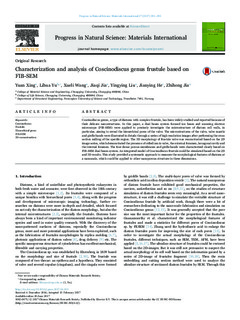| dc.contributor.author | Xing, Yuan | |
| dc.contributor.author | Yu, Lihua | |
| dc.contributor.author | Wang, Xueli | |
| dc.contributor.author | Jia, Jiaqi | |
| dc.contributor.author | Liu, Yingying | |
| dc.contributor.author | He, Jianying | |
| dc.contributor.author | Jia, Zhihong | |
| dc.date.accessioned | 2018-06-28T07:45:24Z | |
| dc.date.available | 2018-06-28T07:45:24Z | |
| dc.date.created | 2017-10-23T15:38:33Z | |
| dc.date.issued | 2017 | |
| dc.identifier.citation | Progress in Natural Science. 2017, 27 (3), 391-395. | nb_NO |
| dc.identifier.issn | 1002-0071 | |
| dc.identifier.uri | http://hdl.handle.net/11250/2503450 | |
| dc.description.abstract | Coscinodiscus genus, a type of diatoms with complex frustule, has been widely studied and reported because of their delicate nanostructures. In this paper, a dual beam system focused ion beam and scanning electron microscope (FIB-SEM) were applied to precisely investigate the microstructure of diatom cell walls, in particular, aiming to reveal the hierarchical pores of the valve. The microstructures of the valve, valve mantle and girdle bands were illustrated in details through a series of high resolution images after performing the cross section milling of the specific region. The 3D morphology of frustule valve was reconstructed based on the 2D image series, which demonstrated the presence of cribellum in valve, the external foramen, hexagonal cavity and the internal foramen. The four dense porous membranes and girdle bands were characterized clearly based on FIB-SEM dual beam system. An integrated model of Coscinodiscus frustule could be simulated based on the 2D and 3D results. This study provided a systematic approach to measure the morphological features of diatoms at a nanoscale, which could be applied to other nanoporous structure in three dimensions. | nb_NO |
| dc.language.iso | eng | nb_NO |
| dc.publisher | Elsevier Inc. | nb_NO |
| dc.rights | Attribution-NonCommercial-NoDerivatives 4.0 Internasjonal | * |
| dc.rights.uri | http://creativecommons.org/licenses/by-nc-nd/4.0/deed.no | * |
| dc.title | Characterization and analysis of Coscinodiscus genus frustule based on FIB-SEM | nb_NO |
| dc.type | Journal article | nb_NO |
| dc.type | Peer reviewed | nb_NO |
| dc.description.version | publishedVersion | nb_NO |
| dc.source.pagenumber | 391-395 | nb_NO |
| dc.source.volume | 27 | nb_NO |
| dc.source.journal | Progress in Natural Science | nb_NO |
| dc.source.issue | 3 | nb_NO |
| dc.identifier.doi | 10.1016/j.pnsc.2017.04.019 | |
| dc.identifier.cristin | 1506938 | |
| dc.description.localcode | © 2017 Chinese Materials Research Society. Published by Elsevier B.V. This is an open access article under the CC BY-NC-ND license(http://creativecommons.org/licenses/BY-NC-ND/4.0/). | nb_NO |
| cristin.unitcode | 194,64,45,0 | |
| cristin.unitname | Institutt for konstruksjonsteknikk | |
| cristin.ispublished | true | |
| cristin.fulltext | original | |
| cristin.qualitycode | 1 | |

